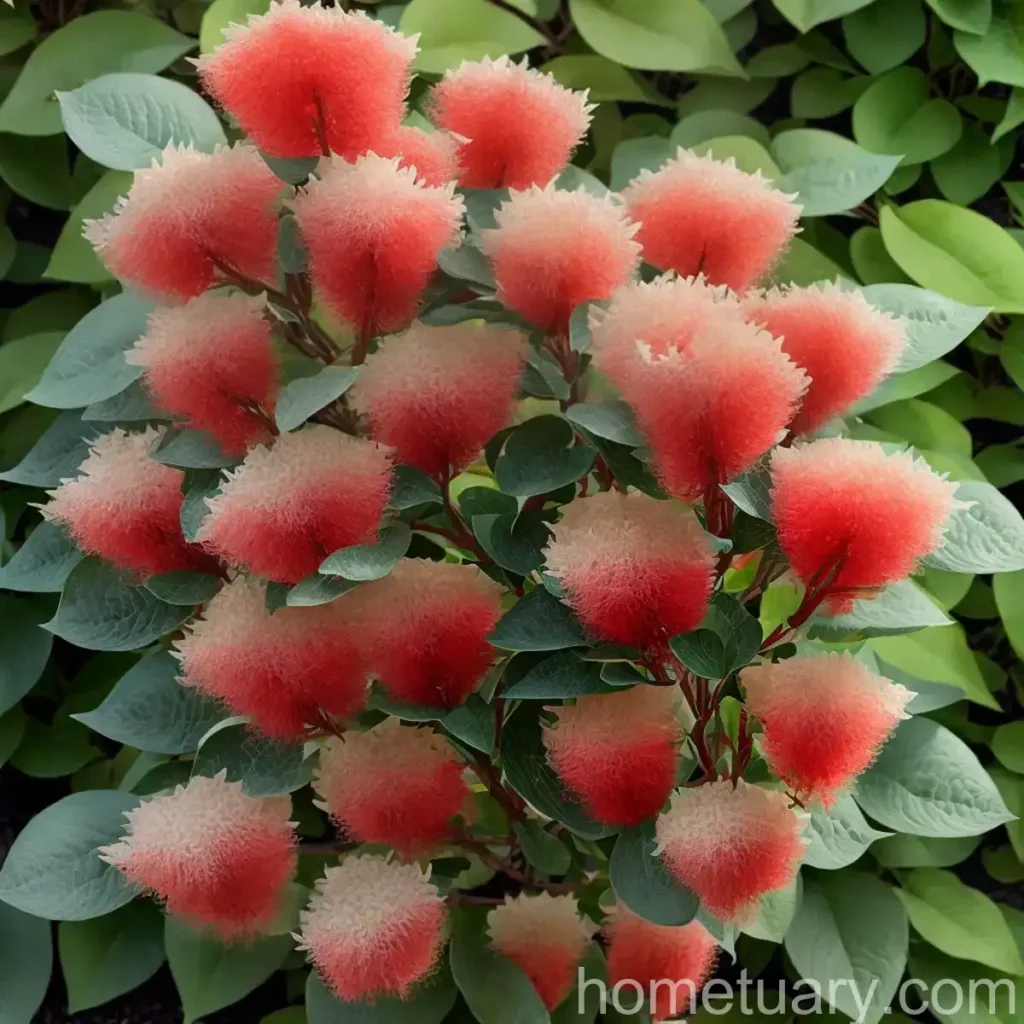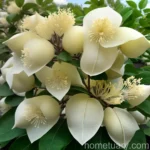Large Fothergilla (Fothergilla Major ‘Red Licorice’) Plant Guide
Large fothergilla, scientifically known as Fothergilla major ‘Red Licorice’, is a stunning deciduous shrub that is prized for its vibrant red foliage and charming bottlebrush-like blooms. This versatile plant is a favorite among gardeners for its low maintenance nature, wildlife appeal, and impressive landscape qualities. In this comprehensive guide, we will delve into the various aspects of this remarkable plant, including its cultural requirements, uses, care tips, and more.
What is Large Fothergilla?
Large fothergilla, or Fothergilla major ‘Red Licorice’, is a member of the Hamamelidaceae family, native to the southeastern United States. This striking deciduous shrub is renowned for its vibrant foliage, compact form, and delightful bottlebrush-like white flowers that emerge in spring. The leaves of Fothergilla major ‘Red Licorice’ offer a kaleidoscope of colors throughout the seasons, transitioning from vivid red in spring, to blue-green in summer, and culminating in stunning shades of yellow, orange, and red during the fall. Beyond its aesthetic appeal, this plant is also valued for its compact size, making it an ideal choice for smaller gardens, borders, and woodland settings.
Key Takeaways
Before delving into the detailed aspects of large fothergilla, let’s summarize the key takeaways:
- Plant Name: Fothergilla major ‘Red Licorice’
- Characteristics: Compact form, vibrant red foliage, white bottlebrush-like flowers
- Cultural Uses: Landscaping, garden borders, woodland gardens, pollinator gardens
- Water: Regular watering, especially during establishment
- Sunlight: Partial to full sun
- Fertilizer: Balanced fertilizer in early spring
- Soil: Moist, well-draining, acidic soil
- Pruning: Minimal pruning, if needed, after flowering
- Propagation: Softwood cuttings in early summer
- Common Pests: Aphids, spider mites
- Common Diseases: Powdery mildew, leaf spot
- Hardiness: Zones 5-8
Now, let’s explore each of these aspects in further detail to gain a comprehensive understanding of this captivating plant.
Culture
Uses
Large fothergilla, with its stunning foliage and charming flowers, serves a multitude of purposes in the garden and landscape. Some common uses include:
- Landscaping: Its compact form and colorful foliage make it an excellent choice for landscaping in both residential and commercial settings.
- Garden Borders: Large fothergilla adds a striking visual interest when planted in garden borders, providing an array of colors throughout the seasons.
- Woodland Gardens: Due to its native habitat, large fothergilla thrives in woodland garden settings, adding a touch of vibrancy to these naturalistic spaces.
- Pollinator Gardens: The fragrant, nectar-rich flowers of Fothergilla major attract pollinators, making it a valuable addition to pollinator-friendly gardens.
Water
Proper watering is essential for the health and vitality of large fothergilla, especially during its establishment phase. Regular watering, particularly during dry spells, is crucial to ensure adequate moisture for the plant. However, it is important to avoid waterlogged conditions, as this can lead to root rot and other detrimental issues. Once established, large fothergilla exhibits good drought tolerance, but supplementary watering during prolonged dry periods can promote healthier growth and foliage.
Sunlight
Large fothergilla thrives in partial to full sunlight. While it can tolerate some shade, providing it with sufficient sunlight is necessary to promote optimal flowering, vibrant foliage colors, and overall plant vigor. When selecting a planting location, consider a spot that receives at least 4-6 hours of sunlight per day for the best results.
Fertilizer
Applying a balanced fertilizer in early spring, prior to the onset of new growth, can provide the necessary nutrients to support the plant’s health and vitality. Opt for a slow-release, granular fertilizer designed for woody plants, and follow the manufacturer’s instructions for application rates. Avoid excessive fertilization, as it can lead to excessive foliage growth at the expense of flower production.
Soil
Large fothergilla thrives in moist, well-draining, acidic soil. It is essential to ensure that the soil is conducive to proper drainage, as waterlogged conditions can be detrimental to the plant. Amending the soil with organic matter, such as compost or peat moss, can enhance its moisture retention and acidity, creating an ideal growing environment for Fothergilla major.
Pruning
Large fothergilla typically requires minimal pruning, and any shaping or corrective pruning can be performed after the plant has finished flowering in spring. Removing any dead, damaged, or crossing branches can help maintain the plant’s overall form and promote air circulation within the canopy. It is advisable to avoid extensive pruning, as large fothergilla blooms on old wood, and excessive trimming can reduce flowering in the subsequent season.
Propagation
Propagating large fothergilla can be achieved through softwood cuttings taken in early summer. Select young, healthy shoots and prepare the cuttings by removing the lower leaves, dipping the cut ends in rooting hormone, and planting them in a well-draining propagation medium. Keeping the cuttings consistently moist and providing bottom heat can facilitate the rooting process. Once rooted, the new plants can be carefully acclimated to their permanent growing locations.
Container Popularity
The compact size and ornamental qualities of large fothergilla make it an attractive choice for container gardening. When grown in containers, it can serve as a focal point on patios, decks, or balconies, adding a touch of elegance with its vibrant foliage and charming blooms. Ensure that the container provides adequate drainage and use a high-quality potting mix to create an optimal growing environment for the plant. Regular watering and fertilization are essential for the health and vigor of large fothergilla grown in containers.
Common Diseases and Pests
Common Diseases
Large fothergilla is generally resistant to most diseases, but it can occasionally be susceptible to certain issues. Two of the common diseases that may affect this plant are:
- Powdery Mildew: This fungal disease can manifest as a powdery white coating on the leaves, compromising their health and aesthetics. Adequate air circulation and avoiding overhead watering can help prevent powdery mildew.
- Leaf Spot: Leaf spot diseases, caused by various fungi, can result in the formation of spots or lesions on the foliage. Remove and destroy affected leaves and ensure that the plant is not subjected to prolonged wet conditions, as this can exacerbate the issue.
Disease Diagnosis
Identifying diseases in large fothergilla involves careful observation of the plant’s foliage, flowers, and overall growth. Keep an eye out for any abnormal discoloration, spotting, or unusual growth patterns, and promptly address any issues to prevent the spread of diseases. Proper cultural practices, such as providing adequate air circulation, proper watering, and maintaining overall plant health, can significantly reduce the risk of diseases.
Common Pests
While large fothergilla is relatively resistant to pests, it may encounter occasional pest issues. Some of the common pests include:
- Aphids: These tiny, sap-sucking insects can cluster on the foliage and tender shoots, potentially causing distorted growth and the formation of sticky honeydew.
- Spider Mites: Spider mites are microscopic pests that can infest the undersides of leaves, causing stippling and discoloration.
Vigilant monitoring of the plant can help detect pest infestations early, allowing for prompt intervention. Insecticidal soaps or horticultural oils can be used to control aphids and spider mites while minimizing adverse effects on beneficial insects.
Botanist’s Tips
To ensure the successful cultivation of large fothergilla and maximize its ornamental appeal, consider the following botanist’s tips:
- Selecting the Planting Site: Choose a planting site that provides the necessary sunlight, well-draining acidic soil, and ample space for the mature size of the plant. Proper site selection can set the stage for the plant’s long-term health and vigor.
- Mulching: Apply a layer of organic mulch around the base of the plant to conserve moisture, regulate soil temperature, and suppress weed growth. An acidic mulch, such as pine bark or pine straw, can help maintain the soil pH favorable for large fothergilla.
- Monitoring Moisture Levels: Regularly monitor the soil moisture levels, especially during dry periods, to ensure that the plant receives adequate hydration. Mulching can aid in moisture retention and reduce the frequency of watering.
- Wildlife Benefit: Appreciate the value of large fothergilla as a wildlife-friendly plant, as its fragrant flowers and vibrant foliage can attract beneficial pollinators and contribute to the biodiversity of the garden ecosystem.
Fun Facts
As we unravel the captivating world of large fothergilla, let’s explore some intriguing fun facts about this remarkable plant:
- Large fothergilla, or Fothergilla major ‘Red Licorice’, is named after the Scottish botanist, Dr. John Fothergill, who was a prominent figure in the field of horticulture and plant exploration.
- The vibrant red foliage of Fothergilla major ‘Red Licorice’ in spring is a delightful sight, adding a bold splash of color to the garden landscape.
- The bottlebrush-like flowers of large fothergilla emit a sweet, honey-like fragrance, attracting bees, butterflies, and other pollinators to the garden.
- Large fothergilla is known for its exceptional fall foliage, with leaves transitioning to brilliant shades of yellow, orange, and red, creating a stunning display of autumn colors.
Links to External Resources
To further enhance your knowledge of large fothergilla and explore additional information, consider referring to the following external resources:
- Fothergilla – Missouri Botanical Garden
- Gardening with Native Plants: Fothergilla – North Carolina State University
- Fothergilla Major ‘Red Licorice’ – Chicago Botanic Garden
By exploring these reputable resources, you can gain valuable insights into the cultivation, care, and landscape uses of large fothergilla, thereby enriching your gardening endeavors.
In conclusion, large fothergilla (Fothergilla major ‘Red Licorice’) stands as a captivating and versatile plant that offers an array of ornamental attributes, from its vibrant red foliage to its delightful spring blooms. Embracing this exquisite shrub in the garden landscape can elevate the aesthetic appeal, contribute to wildlife conservation, and create enchanting seasonal displays. With its low maintenance nature and impressive landscape qualities, large fothergilla holds an esteemed place in the realm of ornamental horticulture, delighting gardeners and nature enthusiasts alike.
References:
- Dirr, M. A., & Heuser, C. W. (2009). Dirr’s trees and shrubs for warm climates. Timber Press.
- Dirr, M. A. (2009). Manual of woody landscape plants: their identification, ornamental characteristics, culture, propagation and uses. Stipes Publishing.
Now that we’ve covered the extensive guide for large fothergilla (Fothergilla major ‘Red Licorice’), you should have a comprehensive understanding of this captivating plant. Whether you’re looking to enhance your garden or landscape, large fothergilla is sure to bring a burst of color and charm to your outdoor spaces!















